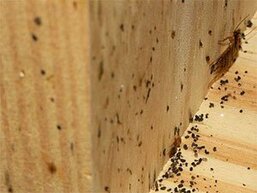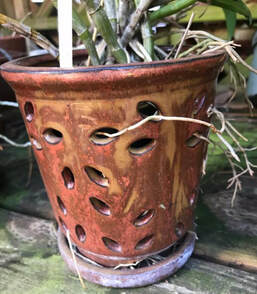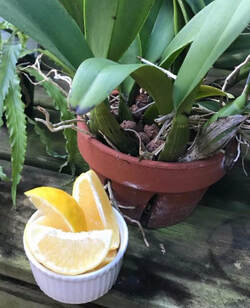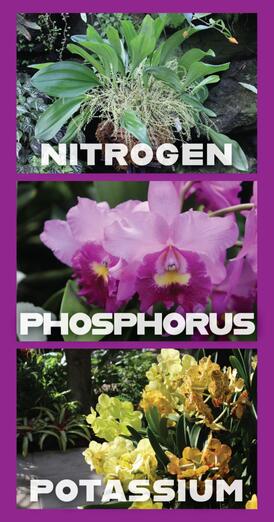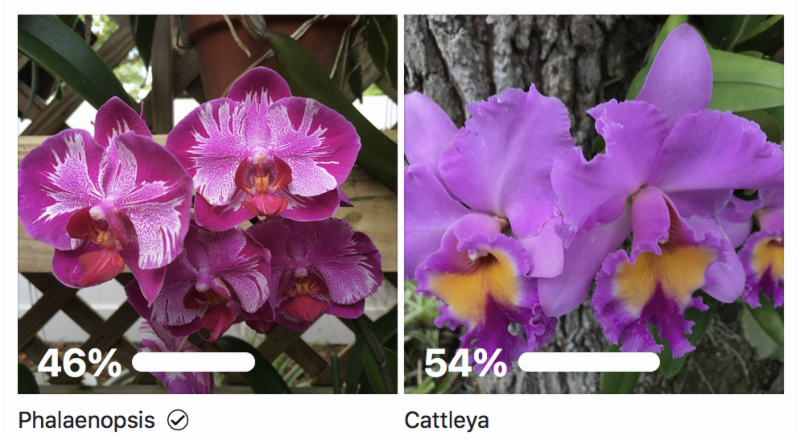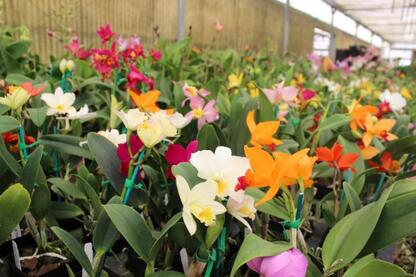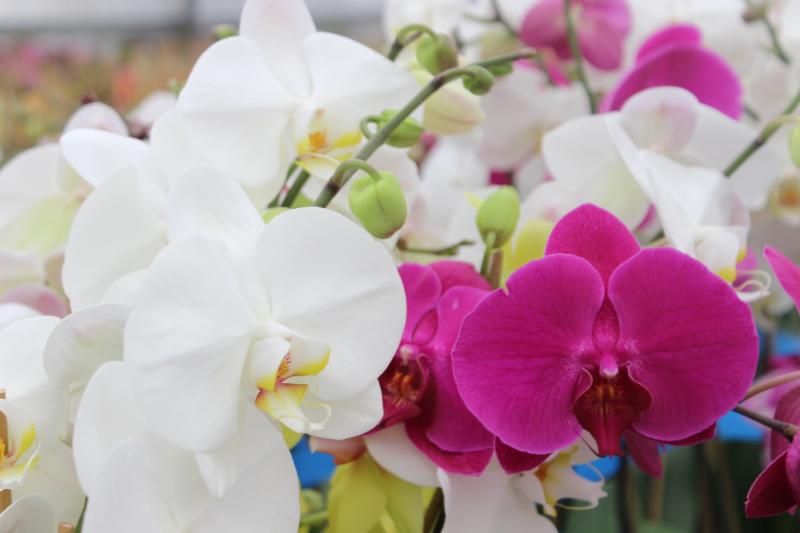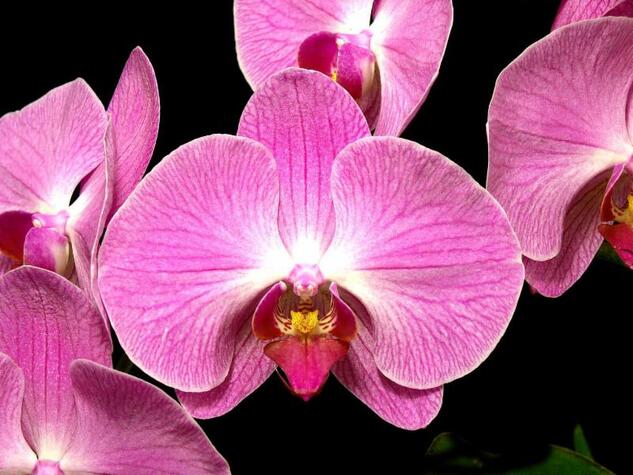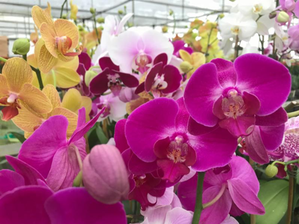 Phalaenopsis in our green house Phalaenopsis in our green house It is such a joy to bring home a new orchid. They brighten up your home and garden, and some varieties stay in bloom for up to three months. Whether you have just a few plants or an extensive collection, here are several steps you should take when bringing home a new orchid from the garden center, grocery store or local orchid show. Check the Moisture Level of the Potting Media Stores do their best to properly care for plants, but under or over watering does occur. If the plant feels heavy from water and the potting media is cool to the touch, wait a few days before watering to allow the excess moisture to be absorbed. If the potting media is dry and/or the leaves look limp, give the plant a good watering, but make sure the water flows through and exits the pot. 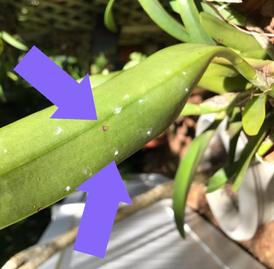 Scale on orchid leaf Scale on orchid leaf Look for Bugs Your new orchid may have left the greenhouse free from bugs, but once exposed to other plants in the store, some critters may decide to move to a new host plant. In addition to inspecting the plant in the store, it is a good idea to do an additional check at home. Some bugs are almost impossible to see with the naked eye, so a simple light rinse of the leaves with water will likely wash away the bugs. If you do happen to notice a small spot of scale or mealy bugs, you can eliminate these pests by wiping the leaves with a cotton ball soaked in 70% isopropyl alcohol. Quarantine If you have a collection of orchids, it’s best to keep your new orchid in a different location for at least a week. This separation will allow you to look for bugs, fungus or bacteria on the new plant before exposing your existing healthy plants to potential issues. 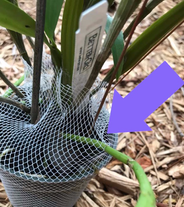 New growth can get damaged by netting New growth can get damaged by netting Remove Netting and Plastic Wraps Growers will often use netting to prevent the potting media from spilling out. Be sure to remove the net or tape once you have brought your plant home to avoid new growth from getting trapped and damaged. Additionally, if your plant has a thin colorful plastic or foil wrap surrounding the pot, it is best to remove these wraps. Orchids are epiphytic and their roots need air flow. These wraps limit that flow and trap water which could cause the plant to rot. If you want to use a decorative pot while your plant is in bloom, simply place the orchid's plastic or terracotta pot inside your preferred pot, making sure the water can drain. 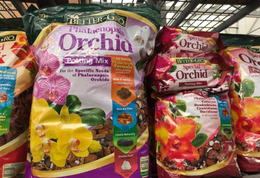 Repot After the Blooms Have Dropped Sphagnum moss is used by many growers to keep plants from drying out during shipping and while in the store. After your orchid has finished blooming, we recommend repotting your orchid in fresh potting mix. If you repot while your orchid is in bloom, the blossoms may prematurely drop. We hope these simple suggestions will help you the next time you bring home your next orchid. Happy Blooming from Better-Gro! 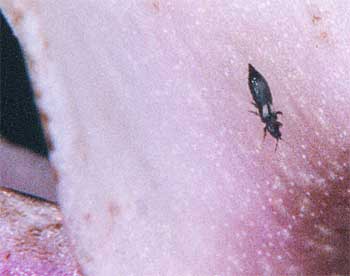 You’ve waited months and carefully nurtured your orchid. You protected your plant from the cold winter months and fertilized it with care. Like a proud parent, your excitement builds as the first spike begins to shoot out from the base of the plant. You pat yourself on the back when not just one bud forms, but multiple buds form along the spike. The anticipation builds only to end in disappointment as your tender buds shrivel before they reach maturity. Thrips: Tiny Pests Sadly, this misfortune can occur with first time orchid owners as well as experienced collectors. One likely culprit is a small insect called Thrips. Thrips commonly attack buds and new growth on many types of orchids including Vandas, Dendrobiums, Cattleyas, Phalaenopsis and Epidendrums. Almost impossible to see with the naked eye, these tiny hemi-metabolic insects range in size from 1/16 to 3/8 inch and are characteristically cigar-shaped. They also attack many other types of plants including edibles such as beans, carrots, squash and other flowering plants like gladioli and roses. Despite their tiny size, thrips can ruin your flowering season. Pest problems do occasionally occur with orchids. Correctly identifying the source of the problem is key to understanding how to treat your orchids and eliminate the pest. In this video, we’ll show you examples of insect problems with orchids and discuss how to remedy the most common problems. 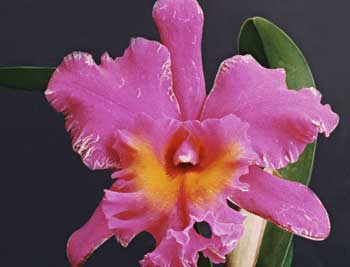 Symptoms Thrips commonly feed in large groups. Most often, they attack buds and new growth, sucking the moisture out of these fragile parts. Blooms may shrivel and drop before opening. Flowers that make it to maturity may be spotted, streaked, shriveled or discolored. If you suspect you have thrips, try gently blowing into an open flower and look for tiny green or white insects. Controlling Thrips It is important to address thrips quickly. Besides damaging your buds and new growth, they may also help spread viruses throughout your collection due to their ability to quickly travel between plants.
Hopefully these tips will keep thrips from ruining your current and future buds and flowers. Happy Blooming!  Photo: University of Florida Photo: University of Florida If our title makes you cringe, you’re not alone! Roaches rank up there as one of the most disgusting things you can find in your home. But did you know they will feed not only on the food in your pantry but munch on your orchids as well? Cockroaches have been around for over 300 million years. Some species pre-date the dinosaurs. So, it’s no surprise that these resilient insects will do anything to survive. Most areas of the U.S. are well into the frigid winter season. It’s dry and cold outside which is exactly why roaches head inside this time of year to seek food and water. Their preferred meal is any type of carbohydrate including green leaves and blossoms. In particular, they find new growth such as root tips and buds extra enticing.
If buying plant food has you saying IDK (short for I Don’t Know) about NPK, don’t worry! You don’t need to be a chemist, biologist or professional grower. We’ve got the answers to help you select the right plant food. So, What is NPK? NPK is an abbreviation for Nitrogen (N), Phosphorus (P) and Potassium (K). Remember the abbreviations on the Periodic Table from high school chemistry class? These nutrients when applied at the right time in the correct amount can help you grow healthier, happier plants. Behind the Numbers Not all fertilizers say “NPK” on the packaging, but you will consistently find three numbers that correspond to the percentage of Nitrogen, Phosphorus and Potassium content in the fertilizer. For example, you may see 10-10-10 on the packaging label which indicates the plant food contains 10% of each of these primary nutrients.
Many of you are familiar with the Better-Gro brand, but you may not know the family or the story behind it. This holiday season, as you prepare to celebrate with friends and family, we wanted to share our family story, and how we have blossomed over the past three generations into a nationally-known wholesale grower and supplier of plant products.  Simply Serendipitous Who doesn’t love a free gift with purchase? Well, if you can believe it, when our company was first started an orchid was the free gift and barbeque sauce was the purchase! A.P. Hollingsworth, founder of Sun Bulb Co. (the parent company for Better-Gro), and his wife Mildred were originally in the BBQ sauce business while bulbs and plants were just a hobby. A marketer ahead of his time, A.P. would give away a free orchid to every consumer who returned a label from his tasty sauce. For an additional 25 cents, they would get a second orchid. Call it fate, fortune or serendipity, but the kitchen where the sauce was made caught fire and destroyed most of the family’s inventory. A.P took it as a sign, sold his patent for the BBQ sauce recipes and jumped full time into the business of growing and selling orchids and bulbs. 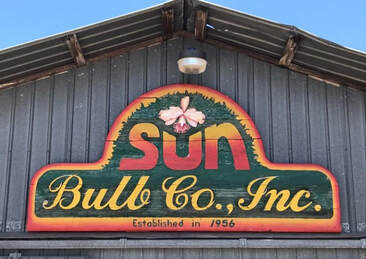 The Next Generation In 1974, A.P. and Mildred’s eldest son, Rodney Hollingsworth joined the family business followed by their youngest son, Tom just three short years later. Under the brothers’ leadership, Sun Bulb grew exponentially over the next three decades to become a well-known, regional wholesale supplier of tropical plants and gardening supplies. As other growers joined the flourishing orchid market, Sun Bulb differentiated itself from the competition by growing a diverse variety of plants for both first-time orchid owners as well as experienced growers. A business model that continues today. 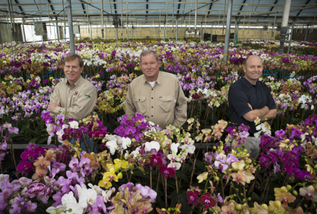 All in the Family A.P. and Mildred’s family legacy now extends three generations. Rodney’s son, Rod Hollingsworth joined Sun Bulb in 2006. Under Rod’s leadership, the company has diversified beyond plants into additional gardening goods including the purchase of Dynamite Plant Food and most recently an exclusive arrangement with plant pot manufacturer's The Kokodama Collection from Holland and Soendgen Keramik (SK) of Germany. Keep Growing
We hope the sharing of our family story has helped put a face behind the Better-Gro label. Our plants are grown with care, and we look forward to continuing to share A.P.’s love of orchids with you. This holiday season, remember to set aside some quality time to grow with your family. Happy Holidays from the Hollingsworth Family and Better-Gro Team. Happy Blooming. One of the most common questions we receive is, “What do I do with my Phalaenopsis once it has stopped blooming?” And our answer is… well, it depends. 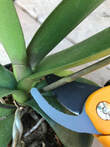 Age Before Beauty If your Phalaenopsis is a younger plant, meaning its leaves and root mass are relatively smaller than a mature plant, we recommend cutting the spike once the blooms have dropped. Use sterile clippers and cut the flower stalk near the base of the plant as shown in the photo. Doing so will allow the plant to focus on developing into a larger, healthier plant so that you can enjoy more blooms the following year. 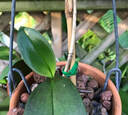 Brown or Green? Sometimes, your orchid will make the cutting decision for you. If your Phalaenopsis spike turns from a dark, healthy green to brown and perhaps even hollow, it’s time to cut. Once a spike has browned, it will never produce more flowers from the same stalk. 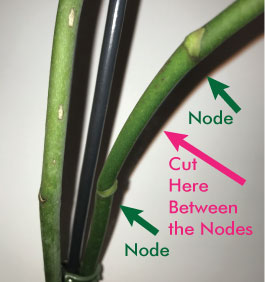 Follow Your Nodes A mature Phalaenopsis can rebloom from the same spike. Assuming your spike is green and healthy, find the node below the lowest initial blossom. (Nodes are the small, brown or green, ring-like markings on the Phalaenopsis flower stalk.) Use a sterile blade or shears to cut half-way between that node and the one below it. To prevent potential infection, you may want to dust the cut with ground cinnamon which acts at a natural anti-fungal treatment. This cutting method is effective about 50% of the time. Some plants are genetically pre-dispositioned for this approach not to work, in particular, Phalaenopsis plants with “sprays” of flowers. 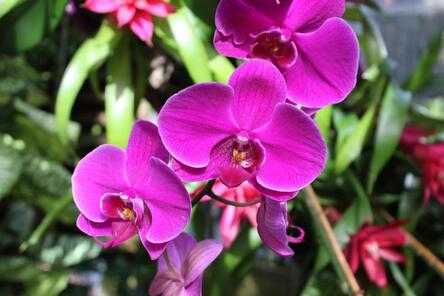 Start Fresh Lastly, you can always guarantee a fresh start for next year by cutting your green Phalaenopsis stems at the base of the plant. Like with younger plants mentioned above, this cutting method will allow your Phalaenopsis to focus it's energy on growing healthier roots and leaves to prepare for the next flowering season. We hope these suggestions answer your question of “To Cut or Not to Cut.” Happy Blooming from Better-Gro!
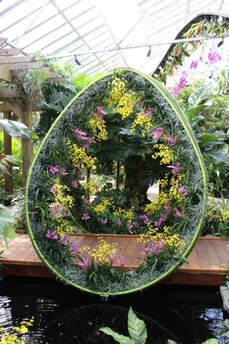 Q: How many orchids were used in this year's show? A: Between our Selby Gardens' expansive orchid collection and the plants we received from Better-Gro and other sources, I estimate that we showcased over 40 different genera and more than 800 orchids. This 90-second video provides a glimpse into the shear variety of orchids and plants on display. Q: With all those plants, how many people and how many hours did it take to assemble the exhibit? A: We had a great team working on the show. There were about 12 staff members and volunteers who worked tirelessly on the setup. It took us six days to build and install the hardscapes and arrange the plants throughout our greenhouse. Q: What was the inspiration for this year's show? A: The Orchid Show: Endless Forms emphasizes the remarkable range of shapes and sizes of different orchid species. The inspiration was drawn from the famous line of Charles Darwin's On the Origin of Species, in which he stated "from so simple a beginning endless forms most beautiful and most wonderful have been, and are being, evolved." 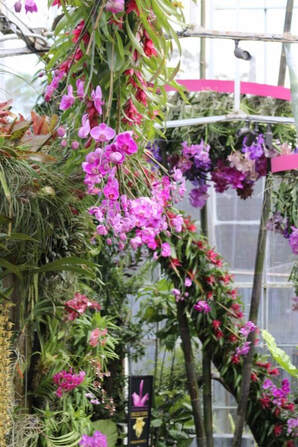 Q: What is unique about the Endless Forms exhibit? A: Well, call me crazy, but we created a 180 foot "endless ribbon" of plants that hung from the ceiling from one end of the greenhouse to the other. We wanted people to look up just as much as they looked down. The ribbon was quite labor intensive with one Phalaenopsis plant approximately every 12 inches which was surrounded by groupings of Guzmanias. The ribbon display required waterings at least twice a day and included over 180 orchids and 430 Guzmanias. In addition, we created what our team affectionately called "Vanda-liers" and "Vanda-shrooms". The Vanda-liers hung like chandeliers at the entry to the gardens as well from the greenhouse ceiling, and the Vanda-shrooms were massive groupings of Vandas displayed at varying heights that gave the appearance of cartoon-like mushrooms. Our team swapped out these massive displays approximately every three weeks. Q: What was unique about the 2018 Orchid Show? A: Well, of course the orchids! But this year's show presented some challenges simply because of the heat. It was one of the hottest years that I can recall. Because our Orchid Show is six weeks long, we always anticipate the need to swap out orchids every few weeks simply because of the blooming cycle. However, this year, we went through even more plants because the flowers wilted much faster than usual due to the heat. Q: When does the Orchid Show end? A: If you haven't made it out to the show yet, it isn't too late! The Orchid Show runs through November 25. Ticket information, directions and hours are available on the Selby Gardens' website. Q: What type of planning goes into the annual Orchid Show? A: The short answer is LOTS. We started working on this show about eight months ago. We'll probably start working on next year's show in January. 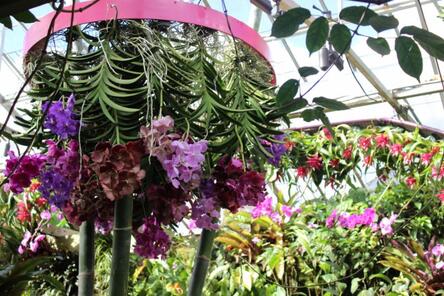 We want to thank Angel Lara and the staff at Selby Gardens for their incredible work on this year's show. Better-Gro was proud to be the presenting sponsor for the event, and we hope you enjoyed our contest and seeing the beautiful photos and videos from the show. Happy Blooming from Better-Gro! We recently polled our Facebook fans and asked the question, “What's easier to grow - a Phalaenopsis or a Cattleya?” To our surprise, the results were almost a tie. 46% of our fans voted for the long-lasting moth orchid (Phalaenopsis) while 54% voted for the showy Cattleya. As with any plant, growing success depends on just the right amount of water, adequate lighting, the correct potting mix and access to nutrients. So, we thought we’d explore what it takes to grow both plants. Our beginners can give both plants a try, and our experienced orchid collectors may make a few changes to their collection. 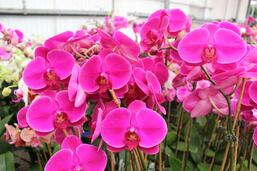 Caring for a Phalaenopsis Light: Phalaenopsis plants prefer indirect sunlight and will also respond well to fluorescent grow lights. An Eastern-facing window is ideal or if you plan to put your orchid outdoors be sure it is filtered light. Direct sunlight can scorch the leaves leaving large round unsightly burns. Water: The Phalaenopsis is not equipped to store water like other orchid varieties which is why it is important to water your plants weekly. Water should run through the pot so that the orchid medium can soak up and retain that moisture. If you are using a plant liner or plant saucer, be sure to drain all the water so that your orchid is not sitting in water which can lead to root rot. Temperature: During the spring and summer months, Phalaenopsis plants prefer warm temperatures in the 75-85 F degree range. However, if you are keeping your Phalaenopsis plants indoors, they will adapt to cooler temperatures. To bloom each spring, Phalaenopsis plants prefer a drop in temperature to spur flower spikes. Potting Medium: Phalaenopsis plants can be grown in various types of orchid media. They do well with mixtures of bark, perlite and charcoal. This medium will retain just the right amount of moisture needed.  Cattleya Care Light: Just like the Phalaenopsis, the Cattleya can be grown indoors with artificial lighting or with indirect sunlight from an Eastern-facing window or filtered Southern exposure window. Water: The Cattleya is able to store water in its pseudobulbs therefore it can go for a longer period of time without water by using its natural water storage. However, it is best to water your plant weekly and be sure the water has completely drained from the pot. Temperatures: Most cattleyas prefer temperatures in the 70-80 F degree range, but in the summer time they can tolerate temperatures into the 90s as long as the plant receives sufficient water and air flow. During the winter, they can handle dips into the 50s. Potting Medium: Cattleyas will grow will in a variety of different media including tree bark, coconut husks, sphagnum moss and even lava rock. When selecting the medium for your plants consider your local humidity and watering routine. Whether you are looking to splurge on a big gift or opt for something simple, flowers are likely to be on your list this Mother’s Day, and you are not alone. It is predicted that nearly 70% of Americans will purchase flowers for their moms and grandmothers this May. But before you head out to pick up an arrangement of cut flowers, consider the benefits of a live orchid. Known for their beauty and longevity, orchid blooms can last for weeks, and plants can live for years. They come in many varieties, sizes and fragrances and can be easily found at your local garden store or home improvement center. Express Your Feelings in Color Giving an orchid is the easy part, but picking the right one or just one may prove difficult. To simplify your selection, we've included some tips to help you express your feelings in color. Pink is traditionally given on Mother’s Day. It signifies thoughtfulness, unconditional love and innocence. Red expresses deep love, respect and courage. Yellow flowers represent happiness, joy and friendship. White signifies innocence, truth, perfection and purity. Purple represents royalty, grace, elegance and admiration. Orange blooms signify enthusiasm and excitement. If you can’t decide what color best represents your mom, give her a rainbow of colors to express your love and gratitude.
From our Better-Gro family to yours, we wish everyone a Happy Mother’s Day. If you are looking for an excuse to add another orchid to your collection, here it is. April 16th is observed annually as National Orchid Day. We’re sure you can come up with a variety of ways to celebrate your love of orchids, but here are a few additional ideas:
Dear Friends & Family:
We want to thank all of you for your inquiries and words of encouragement relative to the impact of Hurricane Irma on our facilities in southwest and central Florida. At Sun Bulb Co, we suffered a terrible beating to our facilities during Hurricane Charlie in 2004 and feared the worst once Irma’s path took the storm so close to our facilities last week. While we have some damage to our greenhouses as a result of Irma, we are blessed to be able to tell you that most of our crop is in great shape and we are well on our way to repairing the damage to the greenhouse structures. Given the severity of the winds / rain with Irma, we truly feel as though we were spared. As of Friday 9/15/17, we have power and phones/internet have been restored thanks to the hard work of our local utility departments. We anticipate being back to a typical routine within the next week or so and will be back to helping make your home and garden beautiful again. From all of us at Better-Gro, thanks for all your support! |
Resources
|
Company |
|

